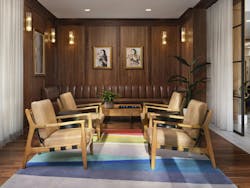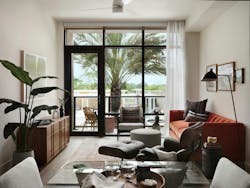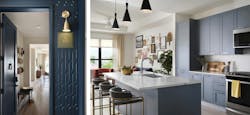Anatomy of a model apartment
Model apartments are like vignettes, offering a moment in time to a visitor—they showcase a quality of life and tell a story that inspires people to live well. These spaces are an important working tool for an operations team and support a successful lease up for both in person and virtual tours.
Page’s interior designers curate units that harmoniously cater to a range of users, allowing visitors to see a once-empty room as a place of respite and a home. According to the National Association of Realtors, 86% of buyers can better visualize their future home when it’s staged.
How to Give an Apartment a Soul
What differentiates an environment is its occupants and their chosen surroundings, so designers, as visual storytellers, often invent a narrative or a persona that describes the type of person living in a unit. The story inside the apartment comes to life with objects that align with the persona, stretching far beyond common style trends and creating moments inside that feel authentic, curated, differentiated, and memorable.
Creating the right persona starts with analyzing big-picture themes, including demographics, location, market pressures, and cultural shifts that impact how potential tenants may perceive and utilize an environment. For example, the Covid-19 pandemic triggered a massive transition where buyers focused on the optimal at-home workspace with the best Zoom backdrop. Designers highlighted these features when marketing apartments, wrapping their benefits into the space’s narrative.
The Westcott Apartments in Houston, Texas, connects a feeling of home in a park setting while integrating luxury, elegance, and comfort. In this multifamily residence, infused with the gracious charm of a mid-century clubhouse, Page designed two model apartments with juxtaposing personalities: The Outdoor Enthusiast and The Collector. Offering models with opposing characteristics allows an apartment building to reach a wider audience.
The 'Outdoor Enthusiast' Renter
The Outdoor Enthusiast’s ambiance offers a more masculine feel with deep, dark wood furniture and finishes. Walking into this space, visitors may envision someone that wears Sperry topsiders and spends their weekends on a boat or hitting the links. Here, the designers included a large record display, even considering what this persona may be listening to. With Ray LaMontagne’s song “Trouble” on the record player, the unit feels like home.
The 'Collector' Renter
Across the hall, the colors in The Collector’s model apartment are softer, and the shapes were more rounded. A marvelous wall filled with artwork and images reflected an international influence, revealing a lifetime of travels and exploration. Instead of a standard coin bowl with pennies and quarters, The Collector’s held foreign currency such as a pound or yen. These carefully selected accessories subtly showcase a person’s values and how they move through the world, which may reflect the lifestyle of prospective residents.
Furniture collection, coloration, and organization are also essential to an environment. Prospective renters or buyers expect to see the staple furniture pieces—such as a bed, sofa, dining room table, and comfortable chairs—but intricate details can make these pieces stand out. A spectacular nail head detail where the leather comes together on a sofa may not stand out as obvious but infuses the space with an overall quality care and attention. Designers will also use color as a tool. A color scheme will often coordinate with interior finishes and flooring. Vibrant layering and drapery will add freshness to the atmosphere.
While each model has an evident personality, interior designers include “easter eggs” and subtle details that may inspire viewers to connect with the space. For example, a pair of slippers under the bench at the entry makes the space feel like a haven where you can relax, a customized dog bowl let’s animal lovers know that the building is pet friendly, and the glorious smell of freshly brewed java will enchant coffee connoisseurs.
Prospective buyers and renters are looking for a home—somewhere they can relax, laugh, spend time with friends and family, and create lasting memories. Page believes a model apartment’s purpose is to alleviate the pressure of apartment hunting, by uniquely showcasing a unit’s potential and tapping into aspirations of the future resident. The model is a memory point, that when successful, imprints positive associations, and helps the property stand out as the future residents contemplate their decision, immediately or long after they have left the tour.




